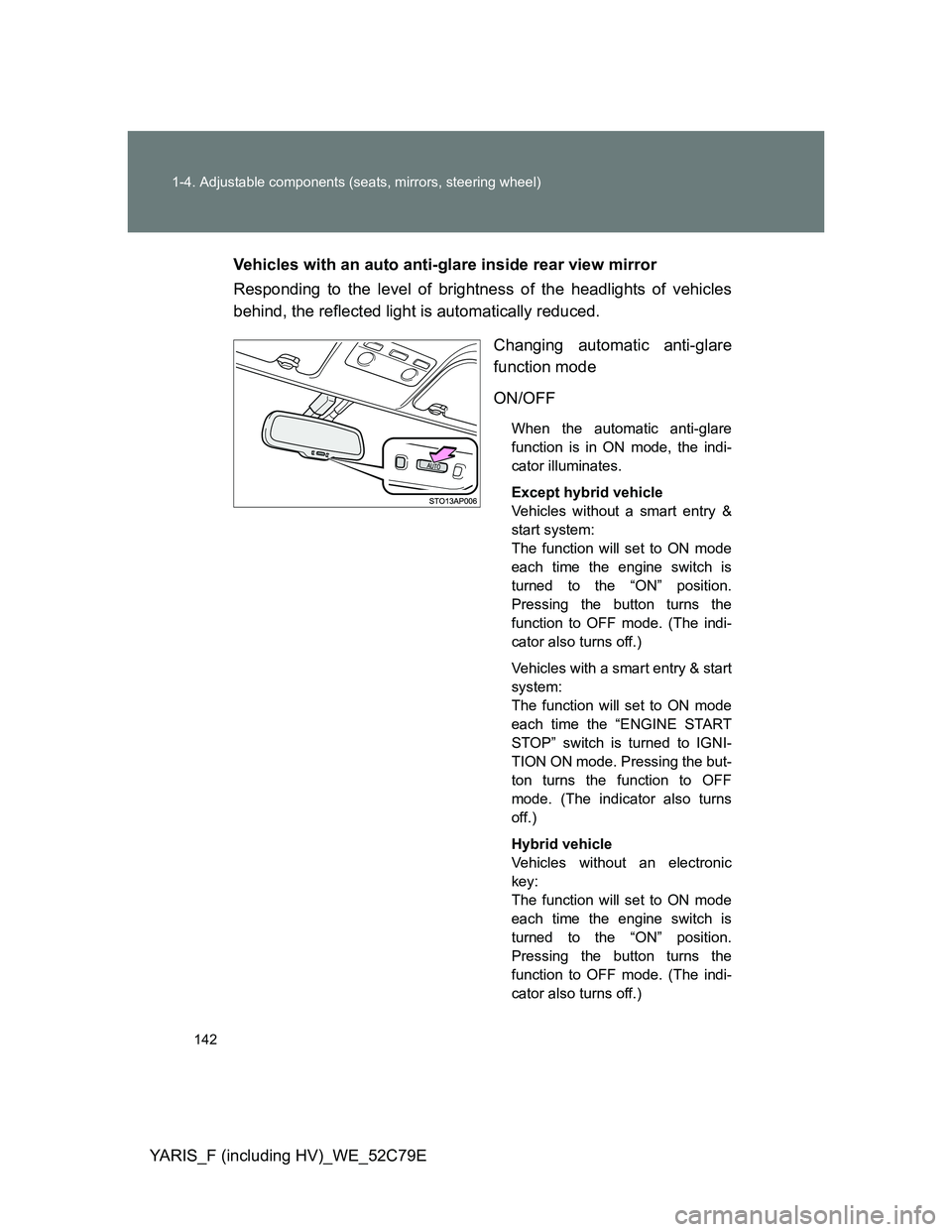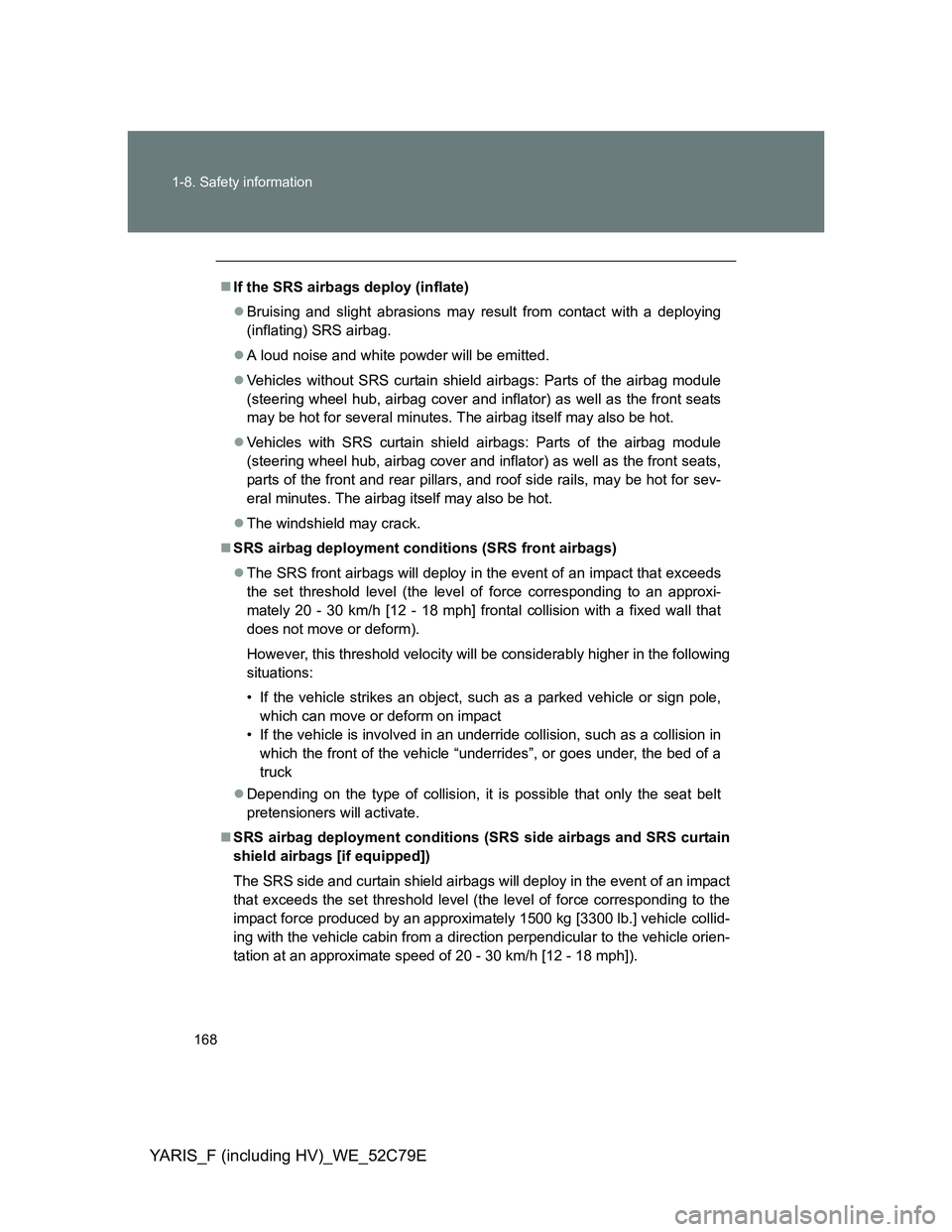Page 142 of 704

142 1-4. Adjustable components (seats, mirrors, steering wheel)
YARIS_F (including HV)_WE_52C79EVehicles with an auto anti-glare inside rear view mirror
Responding to the level of brightness of the headlights of vehicles
behind, the reflected light is automatically reduced.
Changing automatic anti-glare
function mode
ON/OFF
When the automatic anti-glare
function is in ON mode, the indi-
cator illuminates.
Except hybrid vehicle
Vehicles without a smart entry &
start system:
The function will set to ON mode
each time the engine switch is
turned to the “ON” position.
Pressing the button turns the
function to OFF mode. (The indi-
cator also turns off.)
Vehicles with a smart entry & start
system:
The function will set to ON mode
each time the “ENGINE START
STOP” switch is turned to IGNI-
TION ON mode. Pressing the but-
ton turns the function to OFF
mode. (The indicator also turns
off.)
Hybrid vehicle
Vehicles without an electronic
key:
The function will set to ON mode
each time the engine switch is
turned to the “ON” position.
Pressing the button turns the
function to OFF mode. (The indi-
cator also turns off.)
Page 143 of 704
143 1-4. Adjustable components (seats, mirrors, steering wheel)
1
Before driving
YARIS_F (including HV)_WE_52C79E
Vehicles with an electronic key:
The function will set to ON mode
each time the “POWER” switch is
turned to ON mode. Pressing the
button turns the function to OFF
mode. (The indicator also turns
off.)
To prevent sensor error (vehicles with an auto anti-glare inside rear
view mirror)
CAUTION
Caution while driving
Do not adjust the position of the mirror while driving.
Doing so may lead to mishandling of the vehicle and cause an accident,
resulting in death or serious injury.
To ensure that the sensors operate prop-
erly, do not touch or cover them.
Page 144 of 704
144
1-4. Adjustable components (seats, mirrors, steering wheel)
YARIS_F (including HV)_WE_52C79E
Outside rear view mirrors
Mirror angle can be adjusted.
Vehicles with a manually adjustable type
Adjust the mirror up, down, in
or out by pushing the mirror
surface.
Vehicles with a power-adjustable type
To select a mirror to adjust,
press the switch.
Left
Right
To adjust the mirror, press the
switch.
Up
Right
Down
Left
Page 145 of 704
145 1-4. Adjustable components (seats, mirrors, steering wheel)
1
Before driving
YARIS_F (including HV)_WE_52C79E
Folding the mirrors
Push the mirror back in the direc-
tion of the vehicle’s rear.
Mirror operating conditions (vehicles with power-adjustable type)
Except hybrid vehicle
Vehicles without a smart entry & start system:
The engine switch is in the “ACC” or “ON” position.
Vehicles with a smart entry & start system:
The “ENGINE START STOP” switch is in ACCESSORY or IGNITION ON
mode.
Hybrid vehicle
Vehicles without an electronic key:
The engine switch is in the “ACC” or “ON” position.
Vehicles with an electronic key:
The “POWER” switch is in ACCESSORY or ON mode.
When the mirrors are fogged up (vehicles with outside rear view mirror
defoggers)
The outside rear view mirrors can be cleared using the mirror defoggers.
Turn on the rear window defogger to turn on the outside rear view mirror
defoggers. (P. 374)
Page 146 of 704
146 1-4. Adjustable components (seats, mirrors, steering wheel)
YARIS_F (including HV)_WE_52C79E
CAUTION
When driving the vehicle
Observe the following precautions while driving.
Failure to do so may result in loss of control of the vehicle and cause an
accident, resulting in death or serious injury.
Do not adjust the mirrors while driving.
Do not drive with the mirrors folded.
Both the driver and passenger side mirrors must be extended and properly
adjusted before driving.
When a mirror is moving (vehicles with power-adjustable type)
To avoid personal injury and mirror malfunction, be careful not to get your
hand caught by the moving mirror.
When the mirror defoggers are operating (vehicles with outside rear
view mirror defoggers)
Do not touch the rear view mirror surfaces, as they can become very hot and
burn you.
Page 164 of 704
164
YARIS_F (including HV)_WE_52C79E
1-8. Safety information
Correct driving posture
Drive with a good posture as follows:
Sit upright and well back in
the seat. (P. 124)
Adjust the position of the
seat forward or backward to
ensure the pedals can be
reached and easily
depressed to the extent
required. (P. 124)
Adjust the seatback so that
the controls are easily oper-
able. (P. 124)
Adjust the tilt and telescopic
positions of the steering
wheel downward so the air-
bag is facing your chest.
(P. 140)
Lock the head restraint in
place with the center of the
head restraint closest to the
top of your ears. (P. 131)
Wear the seat belt correctly.
(P. 133)
Page 168 of 704

168 1-8. Safety information
YARIS_F (including HV)_WE_52C79E
If the SRS airbags deploy (inflate)
Bruising and slight abrasions may result from contact with a deploying
(inflating) SRS airbag.
A loud noise and white powder will be emitted.
Vehicles without SRS curtain shield airbags: Parts of the airbag module
(steering wheel hub, airbag cover and inflator) as well as the front seats
may be hot for several minutes. The airbag itself may also be hot.
Vehicles with SRS curtain shield airbags: Parts of the airbag module
(steering wheel hub, airbag cover and inflator) as well as the front seats,
parts of the front and rear pillars, and roof side rails, may be hot for sev-
eral minutes. The airbag itself may also be hot.
The windshield may crack.
SRS airbag deployment conditions (SRS front airbags)
The SRS front airbags will deploy in the event of an impact that exceeds
the set threshold level (the level of force corresponding to an approxi-
mately 20 - 30 km/h [12 - 18 mph] frontal collision with a fixed wall that
does not move or deform).
However, this threshold velocity will be considerably higher in the following
situations:
• If the vehicle strikes an object, such as a parked vehicle or sign pole,
which can move or deform on impact
• If the vehicle is involved in an underride collision, such as a collision in
which the front of the vehicle “underrides”, or goes under, the bed of a
truck
Depending on the type of collision, it is possible that only the seat belt
pretensioners will activate.
SRS airbag deployment conditions (SRS side airbags and SRS curtain
shield airbags [if equipped])
The SRS side and curtain shield airbags will deploy in the event of an impact
that exceeds the set threshold level (the level of force corresponding to the
impact force produced by an approximately 1500 kg [3300 lb.] vehicle collid-
ing with the vehicle cabin from a direction perpendicular to the vehicle orien-
tation at an approximate speed of 20 - 30 km/h [12 - 18 mph]).
Page 171 of 704
171 1-8. Safety information
1
Before driving
YARIS_F (including HV)_WE_52C79E
A portion of a door is damaged or
deformed, or the vehicle was involved
in an accident that was not severe
enough to cause the SRS side airbags
and SRS curtain shield airbags (if
equipped) to inflate.
Vehicles without a SRS driver knee air-
bag: The pad section of the steering
wheel or dashboard near the front pas-
senger airbag is scratched, cracked, or
otherwise damaged.
Vehicles with a SRS driver knee airbag:
The pad section of the steering wheel,
dashboard near the front passenger air-
bag or lower portion of the instrument
panel is scratched, cracked, or other-
wise damaged.
The surface of the seats with the side
airbag is scratched, cracked, or other-
wise damaged.
Vehicles with SRS curtain shield air-
bags: The portion of the front pillars,
rear pillars or roof side rail garnishes
(padding) containing the curtain shield
airbags is inside scratched, cracked, or
otherwise damaged.